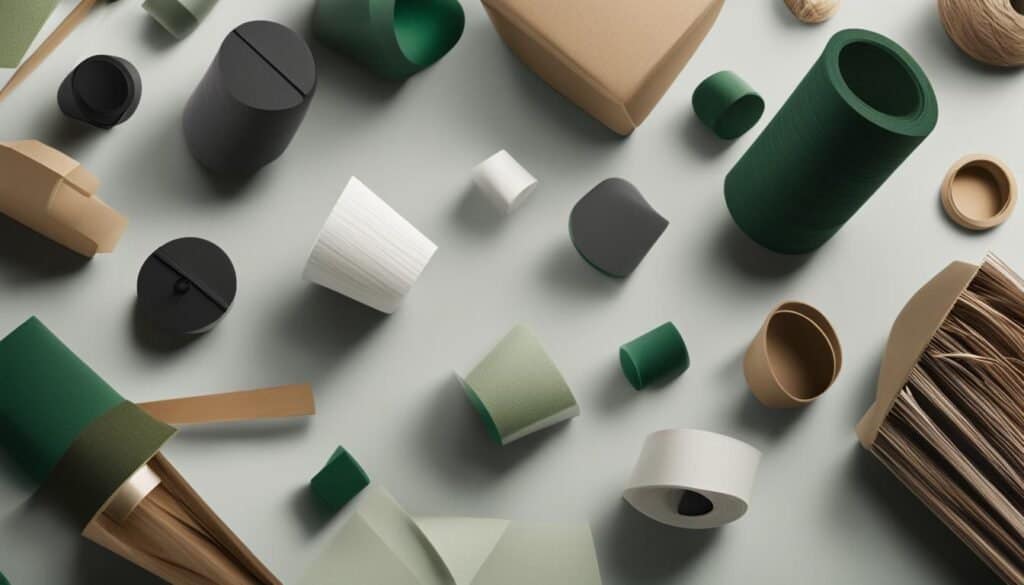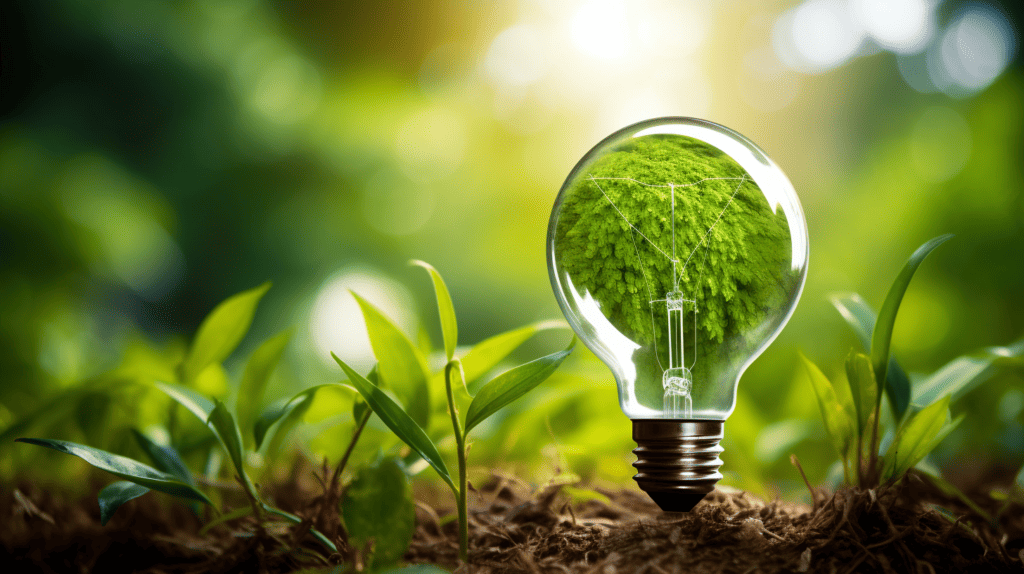As the world continues to grapple with the urgent need for environmental sustainability, eco-design principles for manufacturing have emerged as a key response. With emphasis on sustainable product engineering, eco-friendly product design, and environmental impact reduction, these principles have been defined by life cycle assessment (LCA) methodologies and compliance with international environmental standards, like ISO 14001.
Eco-design hinges upon a comprehensive, cradle-to-grave approach that addresses the global challenge of sustainability in manufacturing. To understand and appreciate these principles, let’s delve into how they have evolved and come to reshape the way products are designed and produced.
Key Takeaways
- Eco-design principles are rooted in environmental sustainability and focus on the entire product life cycle from cradle to grave.
- Life cycle assessment (LCA) serves as a foundational tool in monitoring and addressing environmental impacts of products.
- Key factors in eco-design include material selection, energy and water efficiency, waste minimization, and integration of renewables.
- Durability, reliability, and end-of-life strategies, such as designing for disassembly and recycling, are integral to eco-design.
- Eco-design education plays a critical role in shaping the mindset and future capabilities of the manufacturing industry.
Understanding Eco-Design and Sustainability in Manufacturing
In recent years, the concept of eco-design has taken center stage in the world of manufacturing, aiming to address the growing need for environmental sustainability by creating more eco-friendly products.
This design paradigm shift is influenced by several factors, including national and international regulations, market opportunities, corporate social responsibility, and potential economic and environmental outcomes.
Core77 explains that Design for Disassembly (DfD) is a crucial approach for sustainable product lifecycle, enabling repair and reclamation of components and preparing products for the circular economy.
Eco-design offers numerous benefits to companies and industries; however, its effective implementation remains a challenge, particularly within the technical departments. Key obstacles to the widespread adoption of eco-design include:
- A lack of environmental knowledge among engineers and designers
- Insufficient resources for environmental analysis
- An absence of appropriate methodologies and tools
- Trade-off analysis complications
- Information retrieval difficulties concerning sustainable materials and processes
Recognizing these challenges, businesses are increasingly seeking innovative approaches to overcome implementation barriers and create sustainable products and processes. One strategy involves integrating environmental considerations into every stage of product design, from ideation to manufacturing, ultimately leading to the development of eco-friendly products.
“Eco-design is not about making a single product greener; it’s about transforming an entire industry for a more sustainable future.”
Achieving sustainability within the manufacturing sector requires a diverse and coordinated effort at various levels, addressing multiple objectives, and utilizing a wide range of strategies. Key areas to be considered in the drive towards environmentally conscious manufacturing include:
- Sustainable design of products and processes
- Optimization of energy efficiency
- Minimization of waste, waste water, and emissions
- Implementation of cleaner production technologies
To facilitate the adoption of eco-design principles and sustainability in manufacturing, it is crucial to bridge the knowledge gap between academic insights and industrial application. This can be achieved through targeted training programs, workshops, and seminars aimed at creating a comprehensive understanding of the eco-design concept and empowering decision-makers to pursue environmentally sustainable business practices.
| Benefits of eco-design in manufacturing | Strategies for overcoming implementation barriers |
|---|---|
| Reduced environmental impact | Investing in workforce training |
| Improved corporate image & competitive advantage | Collaboration with research institutions & industry partners |
| Cost savings & resource efficiency | Adoption of appropriate tools & methodologies |
| Compliance with regulations | Establishment of eco-design guidelines & standards |
Ultimately, understanding and embracing eco-design principles within the manufacturing sector is integral to our quest for a more sustainable and environmentally responsible future. By fostering awareness and facilitating the implementation of eco-friendly product design and manufacturing processes, we can make significant strides towards achieving environmental sustainability on a global scale.
Life Cycle Assessment: Driving Eco-Design in Product Engineering
Life Cycle Assessment (LCA) has been an indispensable tool in the field of eco-design in product engineering. While not explicitly mentioned in eco-design standards, this powerful technique has made significant strides in shaping sustainable manufacturing practices by providing insights into materials consumption, energy utilization, and pollution reduction.
Origins and Role of LCA in Eco-Design
The origins of LCA can be traced back to the cradle-to-cradle concept, which emphasizes a holistic approach to environmental sustainability in product design and manufacturing. LCA plays a critical role in monitoring material and energy use as well as tracking environmental pollution throughout the entire product life cycle. This makes it an invaluable resource for developing eco-design methods and strategies.
“Life Cycle Assessment serves as a foundational tool identifying the environmental profile of products, although not explicitly referenced in the eco-design standard.”
Educational initiatives on eco-design often integrate LCA teaching to align with engineering course offerings, aiming to instill sustainable thinking among future industry decision-makers. By fostering a deeper understanding of LCA’s role in eco-design, these educational programs help prepare the next generation of engineers and innovators to tackle the challenges of sustainable manufacturing.
Applying LCA Results to Enhance Environmental Performance
Effectively applying LCA results is crucial for transforming and informing eco-design strategies within manufacturing settings. The utilization of LCA allows manufacturers to assess and improve environmental performances by identifying key areas in product design that require attention, thus facilitating decision-making processes that lead to more eco-friendly solutions.
- Evaluating materials consumption to identify sustainable alternatives.
- Optimizing energy utilization for increased efficiency and reduced carbon footprint.
- Implementing pollution reduction measures to minimize environmental impact.
- Developing sustainable technical solutions that incorporate eco-design principles.
Teaching methods and initiatives targeted at promoting practical application of LCA are vital to instill a comprehensive understanding of eco-design principles and to nurture an environmental consciousness in industrial product redesign. By integrating LCA into eco-design strategy implementation, businesses can achieve more sustainable manufacturing practices and enhance their overall environmental performance.
| Benefits of Applying LCA Results | Examples |
|---|---|
| Optimized material consumption | Substitution of non-renewable materials with more sustainable alternatives |
| Reduced energy utilization | Adoption of energy-efficient technologies, such as LED lighting and high-efficiency motors |
| Decreased pollution levels | Implementation of waste treatment processes and pollution control measures |
| Sustainable technical solutions | Introduction of innovative and eco-friendly designs, such as modular products and reusable components |
In conclusion, Life Cycle Assessment has emerged as an influential driving force behind eco-design in product engineering. By monitoring materials consumption, energy utilization, and pollution throughout the entire product life cycle, LCA enables manufacturers to make well-informed, sustainable decisions and implement eco-design strategies that lead to improved environmental performance.
The Importance of Material Selection in Eco-Design

Choosing the right materials is a cornerstone of eco-design, with an emphasis on options that minimize environmental consequences from raw material extraction through to end-of-life outcomes. Difficulties in sourcing information regarding alternative materials with reduced impact represent a barrier to improved environmental outcomes in product design and development. Overcoming these challenges is key to achieving significant strides in the sustainability of manufacturing products.
Reducing the environmental impact of manufacturing processes can be achieved by selecting sustainable materials that have a lower environmental impact. By doing so, we are greening the supply chain and mitigating negative environmental impacts throughout the product life cycle. Some examples of sustainable materials include recycled materials, renewable resources, and biodegradable substances.
When considering material selection in eco-design, it is essential to consider the following factors:
- Evaluating the environmental impact of the raw materials involved
- Assessing the production processes and their respective emissions
- Examining the potential for material reuse or recycling
- Considering the end-of-life disposal options and their environmental consequences
“Every material choice in eco-design matters; each decision can contribute to reducing negative environmental impacts and promoting a more sustainable future.”
In order to make informed decisions about material selection, it is important to conduct thorough research on available alternatives, their benefits, and potential drawbacks. This can be accomplished by consulting experts in the field, reviewing existing case studies, and attending relevant conferences or workshops to stay up-to-date on the latest trends and findings.
| Material Type | Benefits | Potential Drawbacks |
|---|---|---|
| Recycled Materials | Reduced demand for raw resources, decreased carbon emissions and energy usage | Availability, potential for contamination or compromised quality |
| Renewable Resources | Ability to replenish, reduced environmental impacts, potential for lower costs | Limited locations, technological challenges or impeded supply chain processes |
| Biodegradable Substances | Lower disposal impact, reduced reliance on non-renewable materials | Possible shorter lifespan, challenges in industrial composting facilities or conditions |
In conclusion, material selection in eco-design requires deliberate, informed decisions that weigh both positive and negative factors. By incorporating sustainable materials, alternative options, and more eco-friendly manufacturing processes, we can work towards a more sustainable future for all.
Energy and Water Efficiency: Key Factors in Sustainable Manufacturing

As our world moves towards more sustainable practices, energy and water efficiency have become integral aspects of the eco-design approach. By implementing strategies for energy reduction and water conservation techniques in product design, manufacturers can significantly lower their environmental impact and improve their overall sustainability.
Strategies for Energy Reduction
Reducing energy consumption is a paramount goal of sustainable manufacturing practices. By focusing on minimizing energy use, companies can not only lessen their greenhouse gas emissions but also potentially reap economic benefits via reduced operational costs. Some effective strategies for energy reduction include:
- Optimizing production processes to limit energy consumption.
- Implementing energy-efficient equipment and machinery.
- Utilizing renewable energy sources, such as solar or wind power.
- Conducting regular energy audits to identify areas for improvement.
- Investing in technologies that capture and reuse waste heat.
By adopting these sustainable energy practices, manufacturers have a greater potential to transform their energy-use patterns, resulting in a greener and more cost-efficient operation.
Water Conservation Techniques in Product Design
Water efficiency has also become a crucial aspect of sustainable product design, with eco-design standards emphasizing the importance of water resource management. Reducing water use is essential to mitigating associated environmental impacts and preserving this critical resource for future generations. The following water conservation techniques can be integrated into product design:
- Designing products that require minimal water usage during production or operation.
- Optimizing manufacturing processes to minimize water waste.
- Implementing closed-loop systems that recycle and reuse water within the production facility.
- Choosing materials and processes that have a lower water footprint.
- Ensuring water-related product sustainability through regular evaluations and updating of best practices.
“Water conservation is not only an environmental responsibility, but also an opportunity for manufacturers to make a substantial impact on their long-term sustainability and operational efficiency.”
By incorporating these water efficiency techniques in product design, manufacturers can foster innovative eco-friendly design products and contribute to a more sustainable future for all.
Waste Minimization and Circularity in Eco-Design
Eco-design has the potential to revolutionize the way we approach waste minimization and circularity. By promoting the creation of eco-friendly products with extended lifecycles, eco-design encourages the reuse and recycling of materials, reducing our reliance on virgin resources. This approach is the cornerstone of a circular economy, where products are designed with end-of-life management in mind and waste reduction strategies are implemented holistically.
GreenBiz emphasizes that sustainable product design focuses on minimizing material waste, energy and water consumption, and resources used in fabrication and transportation.
To achieve this circularity, eco-design principles advocate for products that are less resource-intensive, facilitating the adoption of reduce, reuse, and recycle strategies within manufacturing processes. By embracing these strategies, organizations can work towards their zero-waste goals and develop sustainable business models that benefit both the environment and their bottom line.
“Designing a circular economy means embracing waste reduction strategies that enable us to reduce our consumption of resources and protect our environment in the long-term.”
End-of-life management is a crucial aspect of circularity in eco-design. It involves designing products that can be easily disassembled, repaired, or reused, making it simpler for consumers and businesses to recycle or repurpose components when their products reach the end of their useful life.
- Design products with modularity and ease of disassembly in mind.
- Use materials that are easily recyclable or compostable.
- Implement repair and refurbishing programs for products at the end of their life.
- Integrate remanufacturing processes to give products a new lease on life.
These practical techniques help organizations work towards their zero-waste goals, aligning with circular economy principles in their product design and manufacturing processes.
| Circular Economy Principle | Eco-Design Implementation |
|---|---|
| Reduce | Design products with fewer resources and materials. |
| Reuse | Develop products that can be easily repaired, refurbished, or resold. |
| Recycle | Select materials and components that can be readily recycled or repurposed. |
In conclusion, waste minimization and circularity in eco-design are critical elements in driving sustainable innovation. By considering end-of-life management at every stage of the design process, businesses can foster a more responsible, eco-friendly product lifecycle. This approach helps organizations in their pursuit of zero-waste goals, leading to successful long-term growth and a sustainable future for our planet.
Integrating Renewables: The Shift Towards Renewable Materials and Energy

In recent years, the eco-design trend has been pointing towards a significant shift from conventional materials and energy sources to more sustainable, renewable alternatives. By integrating renewables into the manufacturing process, companies can decrease their carbon footprint, transition away from fossil fuels, and promote sustainable development in product design.
Adopting renewable materials and energy sources comes with a myriad of benefits, some of which include:
- Reducing dependency on finite and polluting fossil fuels
- Lowering greenhouse gas emissions
- Supporting local economies by sourcing materials regionally
- Creating innovative and forward-thinking products
Renewable Materials: Innovative Green Solutions
Renewable materials are derived from natural resources that can be replenished over time. Examples of such materials include bio-based plastics derived from plant sources, organic fibers, and responsibly sourced wood. By integrating renewable materials, manufacturers contribute to sustainable manufacturing processes and meet the growing demand for eco-friendly products. Beyond its environmental benefits, leveraging renewable materials often results in cost savings and competitive advantages in the market.
Integrating renewable materials in product design is the perfect synergy of innovation, sustainability, and cost-effectiveness.
Ramping Up Renewable Energy Adoption
Renewable energy sources such as solar, wind, and hydropower unlock sustainable, green energy solutions that align with eco-design goals. By incorporating renewable energy into their operations, companies can reduce their greenhouse gas emissions, decrease reliance on fossil fuels, and demonstrate a commitment to sustainability.
| Renewable Energy Source | Benefits |
|---|---|
| Solar | Abundant, low carbon emissions, scalable |
| Wind | High energy production, clean, scalable |
| Hydropower | Reliable, low environmental impact, versatile |
In conclusion, integrating renewables into eco-design strategies provides a host of environmental, economic, and social benefits to companies and society as a whole. By adopting renewable materials and energy sources, companies can work towards a more sustainable future while showcasing their commitment to innovation and responsible manufacturing.
Redefining Products for Sustainability: Reusability, Recyclability, and Compostability

As sustainable manufacturing practices evolve, so too do enterprises’ strategies for ensuring that their products are environmentally responsible. Some key tenets of these new strategies include reusability, recyclability, compostability, and the incorporation of sustainable materials – all of which help to minimize the ecological impacts of products across their entire life cycles.
Designing for Disassembly and Recycling
The design for disassembly approach encourages manufacturers to create products that can be readily taken apart, repaired, reused, or repurposed, thus reducing the demand for the extraction of virgin materials. This methodology not only promotes a resource-efficient, closed-loop economy, but also extends the product’s useful life and contributes to more sustainable packaging solutions. As a result, the design for disassembly technique facilitates the successful execution of product end-of-life strategies, which ultimately help to decrease waste and conserve valuable resources.
“Design for disassembly and recycling is a proactive approach in eco-design, promoting the creation of products that can be easily taken apart and repurposed or recycled at end of life.”
Embracing Biodegradability and Compostability in Product Life Cycles
Biodegradability and compostability are two increasingly popular strategies for mitigating the environmental impacts of products and their corresponding packaging materials. By integrating these concepts into product design, organizations can help to ensure that their offerings break down naturally over time, thus facilitating a more sustainable disposal process. Beyond the ecological benefits, the adoption of organic product design principles supports a greener brand image and positions enterprises as leaders in the realm of eco-friendly disposability.
- Biodegradability: The ability of a material to decompose over time, facilitated by natural processes such as bacterial action, sunlight, or water exposure.
- Compostability: The capacity for a product or material to break down into nutrient-rich compost, without leaving behind any toxic residue.
In conclusion, redefining products for sustainability involves a comprehensive approach that acknowledges the importance of reusability, recyclability, and compostability, while also emphasizing the need for design for disassembly and recycling techniques. By adopting these principles, organizations can effectively minimize their ecological impacts and contribute to a more sustainable future for all.
Incorporating Durability and Reliability in Eco-Design Principles
Designing sustainable consumer products with longevity in mind involves a dual emphasis on durability and reliability. In eco-design, these aspects are crucial for ensuring that products remain useful for an extended period, contributing to waste reduction and promoting sustainable use habits among consumers.
Extending Product Lifespan through Durability Initiatives
Durability initiatives are fundamental in eco-design for reaching the overarching goal of extended product lifespan. By focusing on quality manufacturing standards and eco-design performance, companies can reduce the volume of waste generated and ensure lasting product functionality. Prolonging product utility in this manner creates longer-lasting items that require less frequent replacement, reinforcing sustainability practices by promoting more resource-efficient consumption patterns.
With durability at the forefront in product design, consumers enjoy a longer service life, fostering a culture of sustainability that aligns with eco-friendly product assurance.
A diverse range of durability initiatives denotes the need for thorough strategies. Current approaches encompass material choices that can withstand wear-and-tear, robust construction techniques, and repairability—encouraging consumers to mend their products rather than discarding them when worn or damaged. These efforts contribute to sustaining products for longer periods, meeting consumer satisfaction, and reducing environmental impacts, ultimately enhancing sustainable use.
Improving Reliability to Enhance Sustainable Use
Reliability constitutes another core facet in eco-design, as it signifies the ability of a product to perform at a consistent level throughout its service life. Offering reliable eco-designs is essential; when consumers trust a product’s functionality, they are less likely to turn to disposables or other less sustainable options. Thus, improving reliability in product design can maximize the sustainable use and longevity of consumer goods, benefiting both the environment and customer satisfaction.
- Quality control: Implementing rigorous quality control measures can reduce the occurrence of product defects and ensure consistent performance.
- User manuals: Comprehensive, easily understandable user manuals can prevent misuse and mishandling, preserving the product’s longevity and performance.
- Post-purchase support: Offering warranty or repair services to consumers can further reinforce the perception of reliable eco-designs and encourage eco-friendly habits like fixing rather than discarding products.
In conclusion, incorporating durability and reliability in eco-design principles is an integral component for a more sustainable future. By extending product lifespans through durable and reliable designs, manufacturers can reduce waste, elevate consumer satisfaction, and facilitate a more environmentally conscious, resource-efficient society.
Conclusion on Eco Design
As we reach the eco-design conclusion, it’s clear that this revolutionary approach is fundamental in transforming manufacturing towards sustainable living. By adopting a holistic sustainability implementation strategy, encompassing material choices, energy and water usage, waste reduction, and integration of renewables, eco-design enables a brighter future outlook in sustainability.
Transformative learning in eco-design plays a pivotal role in bridging the gap between academic insights and industrial application. Education is essential in shaping a new generation of engineers and designers who possess both environmental consciousness and the technical proficiency to drive long-term environmental strategies. By embracing eco-design education for sustainability, manufacturers can better anticipate sustainable production future trends and develop innovative, eco-friendly products.
In conclusion, the seamless integration of eco-design principles into every facet of product development is paramount for achieving a truly sustainable manufacturing industry. Adopting these methods will enhance product quality, efficiency, and reliability, promote responsible consumption, and ultimately contribute to a greener, cleaner planet for future generations.
FAQ On Eco-Design Principles for Manufacturing
Q: What is eco-design?
A: Eco-design, also known as ecodesign, refers to the approach of designing products and services with the goal of minimizing their environmental footprint. It involves integrating environmental protection criteria throughout the design phase, to make new products more eco-friendly and sustainable.
Q: How is eco-design related to LCA (Life Cycle Analysis)?
A: Eco-design is closely related to LCA principles, as it involves analyzing the environmental impact of products and services throughout their entire life cycle. LCA helps in evaluating the design alternatives and closing the lifecycle of products, considering their impact on the environment.
Q: What are some examples of eco-design in manufacturing?
A: Examples of eco-design in manufacturing include designing energy-related products with reduced environmental impact, integrating sustainable materials and technologies, and optimizing product categories to minimize environmental harm.
Q: What is the role of eco-design in sustainable product engineering?
A: Eco-design is a crucial aspect of sustainable product engineering as it consists of integrating environmental protection criteria into the design thinking and process. It ensures that products and services are designed with a minimal impact on the environment, thus contributing to sustainable engineering practices.
Q: How does the eco-design approach involve the environmental agency’s guidelines?
A: The eco-design approach involves adhering to the guidelines and criteria set forth by environmental agencies, ensuring that the products and services meet the required environmental standards and regulations.
Q: Why is eco-design considered an essential element in manufacturing and production?
A: Eco-design is considered essential in manufacturing and production because it focuses on reducing the environmental impact of products and services, ultimately contributing to sustainable and responsible manufacturing practices.
Q: What are the key principles of eco-design in relation to manufacturing?
A: The key principles of eco-design in manufacturing include considering the entire life cycle of products, integrating sustainable materials and technologies, and continuously seeking design alternatives that minimize environmental harm.
Q: How does eco-design contribute to the circular economy?
A: Eco-design contributes to the circular economy by ensuring that products and services are designed with the intention of closing the lifecycle loop and minimizing waste, thus aligning with the principles of a circular and sustainable economy.
Q: What are some benefits of implementing eco-design strategies in manufacturing?
A: Some benefits of implementing eco-design strategies in manufacturing include reduced environmental impact, enhanced product sustainability, potential cost savings, and improved market competitiveness due to eco-friendly product offerings.
Q: How can companies incorporate eco-design into their product development processes?
A: Companies can incorporate eco-design into their product development processes by integrating eco-design principles into the early stages of product development, considering environmental criteria throughout the design phase, and collaborating with specialists in eco-friendly materials and technologies.





Leave a Reply